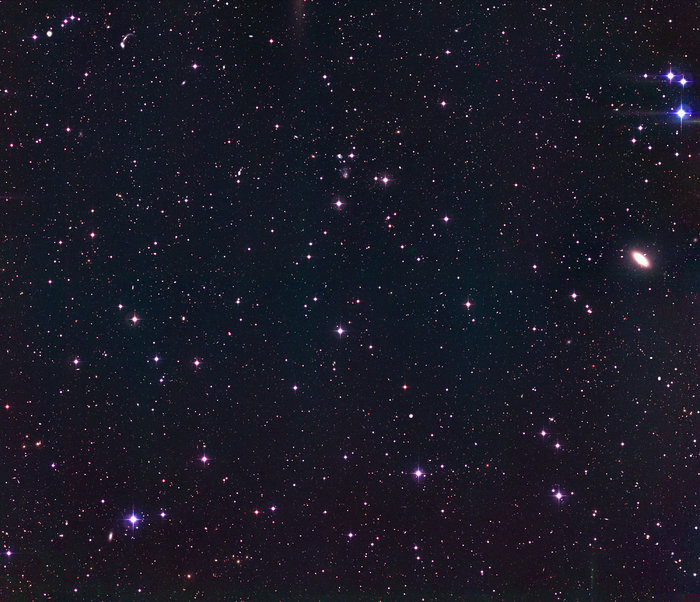Caros Leitores;
This is a three-colour image of about 1/4 of the Capodimonte Deep Field (OACDF) obtained with the Wide-Field Imager (WFI) on the MPG/ESO 2.2-m telescope at the la Silla Observatory. It covers "OACDF Subfield no. 2 (OACDF2)" with an area of about 35 x 32 arcmin 2 (about the size of the full moon), and it is one of the "deepest" wide-field images ever obtained. It has been obtained by the combination of the B, V, and R stacked images of the OACDF2 field. The total exposure times in the three bands are 2 hours in B and V (12 ditherings of 10 min each were stacked to produce the B and V images) and 3 hours in R (13 ditherings of 15 min each). The mosaic images in the B and V bands were aligned relative to the R-band image and adjusted to a logarithmic intensity scale prior to the combination. The typical seeing was of the order of 1 arcsec in each of the three bands. Preliminary estimates of the three-sigma limiting magnitudes in B, V and R indicate 25.5, 25.0 and 25.0, respectively. More than 35,000 objects are detected above the three-sigma level.
Technical information: this image has been obtained by the combination of the B, V, and R stacked images of the OACDF2 field. The total exposure times in the three bands are 2 hours in B and V (12 ditherings of 10 min each were stacked to produce the B and V images) and 3 hours in R (13 ditherings of 15 min each). The mosaic images in the B and V bands were aligned relative to the R-band image and adjusted to a logarithmic intensity scale prior to the combination. The typical seeing was of the order of 1 arcsec in each of the three bands. Preliminary estimates of the three-sigma limiting magnitudes in B, V and R indicate 25.5, 25.0 and 25.0, respectively. More than 35,000 objects are detected above the three-sigma level. North is up and East is left.
Crédito: ESO
Fonte: Observatório Europeu do Sul (ESO, na sigla em inglês
https://www.eso.org/public/brazil/images/eso0116a/
Obrigado pela sua visita e volte sempre!
Web Science Academy; Hélio R.M.Cabral (Economista, Escritor e Divulgador de conteúdos da Astronomia, Astrofísica, Astrobiologia e Climatologia).Participou do curso (EAD) de Astrofísica, concluído em 2020, pela Universidade Federal de Santa Catarina (UFSC).
Autor do livro: “Conhecendo o Sol e outras Estrelas”.
Acompanha e divulga os conteúdos científicos da NASA (National Aeronautics and Space Administration), ESA (European Space Agency) e outras organizações científicas e tecnológicas.
Participa do projeto S`Cool Ground Observation (Observações de Nuvens) que é integrado ao Projeto CERES (Clouds and Earth´s Radiant Energy System) administrado pela NASA. A partir de 2019, tornou-se membro da Sociedade Astronômica Brasileira (SAB), como astrônomo amador.
Participa também do projeto The Globe Program / NASA Globe Cloud, um Programa de Ciência e Educação Worldwide, que também tem o objetivo de monitorar o Clima em toda a Terra. Este projeto é patrocinado pela NASA e National Science Fundation (NSF), e apoiado pela National Oceanic and Atmospheric Administration (NOAA) e U.S Department of State.
>Autor de cinco livros, que estão sendo vendidos nas livrarias Amazon, Book Mundo e outras.
Acesse abaxo, os links das Livrarias>
https://www.amazon.com/author/heliormc57
https://publish.bookmundo.pt/site/userwebsite/index/id/helio_ricardo_moraes_cabral/allbooks
e-mail: heliocabral@coseno.com.br


Nenhum comentário:
Postar um comentário